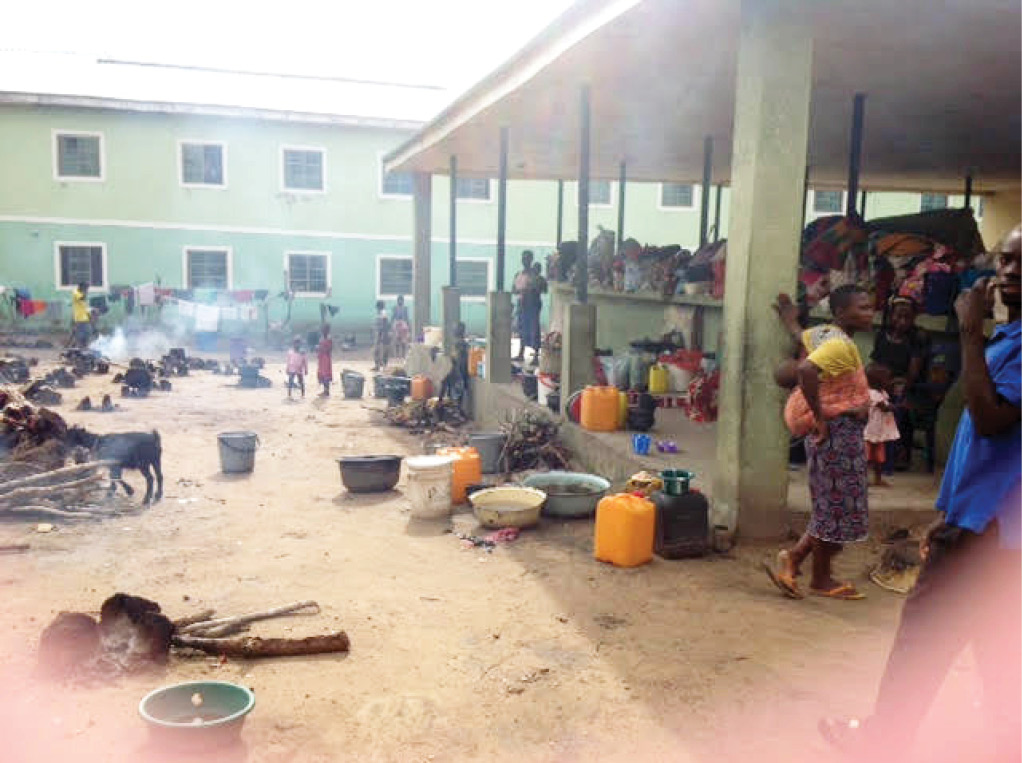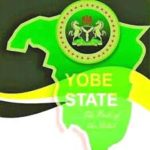Camps for internally displaced persons (IDPs) in Nigeria are fast becoming permanent homes for the victims of communal clashes, banditry, insurgency, natural disasters and other forms of insecurity.
Most of the displaced persons have spent more than six years in their makeshift shelters as they are yet to be relocated, Daily Trust on Sunday reports.
- Boko Haram: Mission helps 40,000, seeks more help for IDPs
- Flood: Bayelsa IDPs now cook inside canoes
In Borno, Yobe, Adamawa and the Federal Capital Territory (FCT), Abuja, there are at least 2,830 displaced persons. Having spent more than six years in various camps, they have integrated into the society.
Some of the camps now have facilities like pharmacies, schools, mosques and empowerment centres.
While most shelters at the camps were made from tarpaulins, some of them have buildings with bricks.
Some toilets were constructed by the Federal Ministry of Water Resources.
Some of the facilities were donations from agencies, corporate institutions and individuals.
One of the displaced persons who spoke with Daily Trust, Bala Lawal Yusuf, said there were 215 households scattered across various locations in Durumi, Abuja.
These households consist of 1,750 youths and 740 children. And the population of the displaced person is increasing.
“Durumi camp, which is one of the 15 in the FCT, is usually filled with women during the day as the men take to commercial motorcycling, taxing and menial jobs to survive,” Yusuf said.
He said the women were also empowered by groups and individuals.
According to him, 52 are into tailoring while 37 produce liquid soaps and caps respectively.
Yusuf said he did not know when they would return to their villages, and as such, they decided to make the best out of their situation.
Another displaced person from Gwoza Local Government Area of Borno State, Hamman Julde, said he got to the camp in 2014.
Julde, his wife and children sleep on a mat in a makeshift shelter made from tarpaulin.

But in Borno State, thousands of people who were displaced by insurgency and lived in camps for many years have, however, been relocated to their ancestral homes by the state government.
Some were also moved to transitory camps in their local government headquarters, preparatory to movement to their respective villages.
Apart from the 20 camps in Maiduguri, the state capital and three neighbouring liberated communities, where there were 38,000 displaced persons, thousands lived in Monguno, Bama, Gubio, Konduga, and other local government areas.
Although it is not conducive to live in camps, displaced persons are forced to stay there for a very long time.
Ari Mama, 63, was a carpenter and livestock farmer in Marte before he was displaced by insurgency in 2014.
Mama, who was comfortable before the advent of insurgency, said that for the period he lived in the camp, there seemed to be no end in sight, so he had to cope with whatever life threw at him.
He said, “I have since adjusted to the living condition of the camp after six years.”
Mama lives in the camp with his three wives and 17 children for six years.
“I have 18 children, but one is not with me here.
“He is married with children and now lives in the host community.
“I am used to this life,” he said,
He said that initially, it was very difficult for him and his wives to come to terms with activities in the camp because of his background.
“Before insurgency, I was a popular carpenter. I made furniture, which I took to neighbouring countries.
“I was also into livestock farming before the insurgents drove away my 158 cattle at once, leaving only one bull behind.
“But I have since embraced the way of life of the people in the camp,” he said.
Also, Bakura Bukar said he fled Marte town with his two wives and children and took refuge in a camp, adding, “We have gradually become permanent residents.”
A senior special assistant to the Borno State governor on media, Baba Sheikh Haruna, said displaced persons living in temporary camps were being returned to their original communities by the state government in a “dignified manner.’’
He said resettlement was done in phases because houses, public buildings and other facilities destroyed by insurgents had to be rebuilt.
The governor’s aide said many people displaced in Bama, Gwoza, Ajiri, Kawuri, and Baga were returned, while an arrangement was being made for displaced persons to return to Marte.

Recently, banditry and floods displaced many people from their homes in Niger State.
The recurring attacks forced residents to seek refuge in camps, which increased in number in different parts of the state.
An official of the Niger State Emergency Management Agency (NSEMA), Mr Ibrahim Audu, said there were about 24 displaced persons’ camps in the state.
He said some of the camps were still functioning due to the regular influx of people there.
There are camps in Kwakuti, Munyan, Gwada, Kuta, Pandogari, Kagara, Tegina, Kotonkoro, Bangi, Ibeto, Kaboji, Ibbi, Bosso.
The camps at Kuta, Gwada, and Kagara are gradually becoming permanent.
The state also has some camps majorly for flood victims in Chegama, Ketco, New Muregi, Danchitagi, Munye, Gima, Awuru, Suleja, Kachina and Baro.
Hajiya Fati Salihu, one of the elderly women at the Kuta camp, said government should do everything within its power to return them to their homes, adding that there should be a lasting solution to banditry.
Hajiya Fati, who is in her late 60s, was displaced from Moguga village some months ago.
During the attack by bandits in that village, many people were killed, others kidnapped and property carted away.
According to her, she first left her community for Gwada at the onset of the attack, hoping that the insecurity in the place would go down, but since it persisted, she came to the camp.
“Staying in the camp is traumatising and destabilising.
“We cannot compare this place to our homes because we have been deprived of so many things and activities.
“Unfortunately, we no longer have peace in our homes because of the activities of bandits, and in the camp we are not emotionally stable. This place is strange to me,’’ she said.
Narrating his experience in the camp, Zakari Galadima, who was displaced from Masuku village, said the best thing government would do for them is to ensure that peace returns to their communities so that they could return home and continue with their lives.
In Benue State, farmers-herders crisis is increasing the population of displaced persons in various camps.
However, the initial 20 camps in the state have been reduced to 10 since security operatives intensified activities against the situation.
But temporary camps at Abagena, along Makurdi-Lafia road, Agan, Mbawa in Daudu, UNHCR in Daudu, Logo and Gbajigbma in Guma, among others, are becoming ‘permanent’ homes.
Also, there are camps for Cameroonian refugees in Kwande Local Government Area.
Our correspondent reports that some of the people have lived in unofficial camps for at least five years, while majority of the displaced persons began to inhabit the camps since January 2018.
Hembafan Ityongi, who fled her village in a boundary community between Nasarawa and Benue states since January 2018, has been in the camp with her family members for over two years.
Besides Ityongi, many occupants of the Abagena camp shared similar experiences, having also lived in the camp for over two years.
At the beginning, the State Emergency Management Agency (SEMA) figured out that there were over 180,000 displaced persons in eight camps, covering Guma, Logo and Makurdi local government area, while over 500,000 people stayed with relatives or in uncompleted buildings.

The executive secretary of the SEMA, Emmanuel Shior later disclosed that there were six official and 22 unofficial displaced persons’ camps in Guma, Logo, and Makurdi.
Recently, Shior also raised concern about the welfare of over 6,000 Cameroon refugees at the Anyake camp in Kwande.
“We have been managing them there.
“And their population keeps increasing because we keep receiving what we call walk-ins or new arrivals.
“But at the moment, we have about 6,000 refugees in the Anyake camp,’’ he said.
He added that following concerns from the host communities and other partners on the need for the refugees to have more space for farming and other things to assist their livelihood, the government had approved for them to be moved to the Ikyogen Cattle Ranch.
Some of the displaced persons said they wanted to return to their homes but needed government’s backing, in terms of rebuilding their destroyed houses and providing them with farm needs.
Shior said the decision to close the camp had been considered, but the displaced persons had no home or farms to return to.
The SEMA boss added that the state government donated a vast parcel of land for the resettlement of the displaced persons.
He said that until the process is concluded, the state government cannot close the camps.
Agatha Orkaa, a widow and one of the leaders of the displaced persons at the Abagena camp, desires to return home but worries that there are no houses or farms.
She also lamented that her valuables, as well as their community school, were all gone with the mayhem visited on them nearly three years ago now. “Where do I go from here?’’ She asked.
In Kaduna State, there are displaced persons’ camps in Gonin Gora in Chikun Local Government Area, as well as Zangon Kataf, Mariri in Lere Local Government Area and Ladugga in Kachia Local Government Area.
Most of the displaced persons, our correspondent gathered, have either left the camps for their homes or living with relatives in various communities.

In Ladugga, a 62-year-old Jafaru Isa told our correspondent on phone that they moved to that place after their village in Gora, Zangon Kataf, was attacked and many people killed in July.
Isa explained that in Ladduga, they had made tents from leaves to protect their families from the rain because there was no shelter.
“Life has been difficult here, but we are planning to return to our village in Gora since there is relative peace now.
“Many people who fled the community with us have returned, so we also plan to return,” he said.
At the Mariri camp, it was gathered that many of the displaced persons slept on corridors and in mosques.
Ibrahim Musa said he would soon return home, adding, “We don’t have food here, and life has been difficult because there is no one to assist us.”
Esther Gado, who once lived at Mercy camp in Zangon Kataf, told Daily Trust that they relocated home in September after two months.
Mercy came into existence a few months ago following a renewed violence in July.
In August, the camp coordinator,
The Reverend Gambo Waziri, said the camp accommodated over 1,000 people.
In September, building materials, including bags of nails, roofing sheets and hundreds of bags of cement were distributed to the displaced persons by church organisations, the Southern Kaduna Peoples Union (SOKAPU) and other groups and individuals so that they could return to their homes and rebuild.
It was gathered that some displaced persons in Gonin Gora relocated to communities to live among their people.
They only go to the camp when help comes.
The Commissioner for Internal Security and Home Affairs in Kaduna State, Samuel Aruwan, did not respond to calls to his phone when he was contacted for official reaction.

 Join Daily Trust WhatsApp Community For Quick Access To News and Happenings Around You.
Join Daily Trust WhatsApp Community For Quick Access To News and Happenings Around You.


